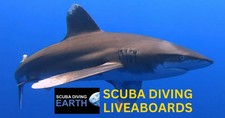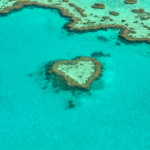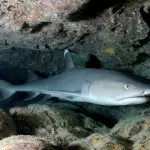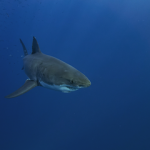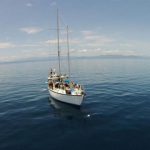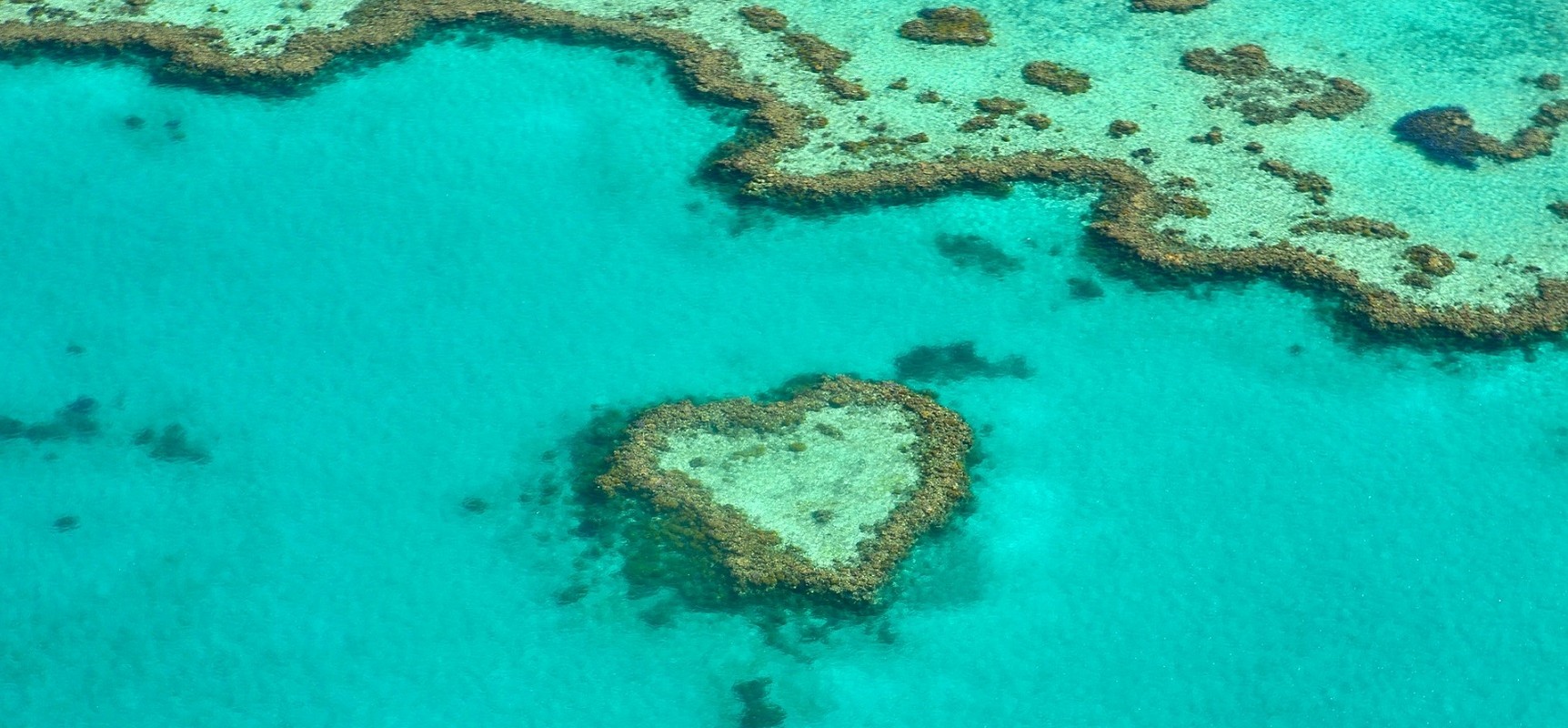
Great Barrier Reef Liveaboard Diving
Liveaboard Diving The Outer Reef And Coral Sea Of The Great Barrier Reef With Sharks, Turtles, Minke Whales And Abundant Marine Life
Popular Great Barrier Reef liveaboards
| MY Spoilsport; Liveaboard diving in Australia; 9.4 out of 10 and is rated 'Superb'; from £292, $356, €333/day. Customer Review: “Doesn’t get much better……The diving was organised to a very professional standard. Nitrox was available (though an extra charge) and 15 litre tanks also available (again extra). Every dive was preceeded by a detailed briefing and a guide was available, though you could dive with a buddy if preferred. 4 or 5 dives a day were offered. Luckily we were blessed with great weather and easy dives. Probably the best dive was a shark feed – 40/50 reef sharks + giant cod all in a feeding frenzy. The food on board was excellent – all tastes and diets catered for. The cabins were very comfy – good bunks, adequate storage and functional bathroom. On the last night we had a party – some guests were professional musicians so we had a good show….& all the crew got everyone up dancing. I was a liveaboard virgin but now a total convert.” Recommended for: Organisation of diving, the crew, comfort of boat. |
| MY Ocean Quest; Liveaboard diving in Australia; 9 out of 10 and is rated 'Superb'; from £152, $185, €173/day. Customer Review: “Wonderful Experience with Ocean Quest on GBR. Liveaboard provides a much more relaxed and enjoyable dive experience than day trip boats – well worth the extra cost. We got to experience the GBR with great guides and then share our experiences with the other guests over a meal or a beer in the bar. The diversity at GBR is just awesome and getting to experience sea turtles, cuttlefish, sharks, unicorn fish and all the other colorful and unique species we encountered.” Recommended for: Warm showers when you wanted/needed, a bed to rest on .. and the crew. |
| MY Pro Dive Cairns; Liveaboard diving in Australia; 9.2 out of 10 and is rated 'Superb'; from £176, $215, €201/day. Customer Review: “You will feel like a pro in notime! Seeing the “mushroom” coral; seeing Brian the 150 y.o. turtle; at 6am after struggling to wake up and putting on a cold stinger suit that feeling when you are finally in the water; the growth of confidence!” Recommended for: Lots of diving, meeting new friends, chilling on the upper deck. |
TO SEE ALL GREAT BARRIER REEF LIVEABOARDS SCROLL TO THE TABLE BELOW
Liveaboard Diving in Great Barrier Reef
Great Barrier Reef liveaboard diving is the best way to explore the much less visited Outer Reef of the Great Barrier Reef. The best time to dive the Great Barrier Reef is June to December when nature aligns for great diving to enjoy the spectacular turquoise Coral Sea and diverse marine life.
One of the best ways to truly experience the diving on the Great Barrier Reef, is on an Australia liveaboard. The Great Barrier Reef is on most scuba diver’s bucket list, and is a must see location for many non-divers too. In fact, why not use the experience to learn to dive (That’s where I did my very first scuba dive).
Great Barrier Reef liveaboards will take you to locations on the outer reef that cannot be reached by the day boats out of Cairns.
The day trips visit the crowded inner reef for a few hours and give divers the chance of two-tank dives. But on a Great Barrier Reef liveaboard, this gives divers the best way to truly experience the underwater marvels of the outer reef too where not so many divers venture, and where the dives are less crowded.
So by setting sail on a Australia diving liveaboard cruise for a few days, you’ll do multiple dives each day, that will include night dives, and will allow you to truly immerse yourself into the Great Barrier Reef experience.
The Great Barrier Reef stretches for 2,300 kilometres (1,438 miles) along the east coast of Australia, and is one of the world’s natural beauties, one of the seven natural wonders of the world and a World Heritage Site:
“The Great Barrier Reef is a site of remarkable variety and beauty on the north-east coast of Australia. It contains the world’s largest collection of coral reefs, with 400 types of coral, 1,500 species of fish and 4,000 types of mollusc. It also holds great scientific interest as the habitat of species such as the dugong (‘sea cow’) and the large green turtle, which are threatened with extinction.”
Unesco – The Great Barrier Reef
The Great Barrier Reef comprises of more than 900 islands and 2,900 individual reefs. The northern tip includes Lizard Island in the north of Queensland, the ‘Sunshine’ state, and the southern tip is close to Heron Island in the south of Australia’s ‘Sunshine’ state.
Visit the Great Barrier Reef by liveaboard, which is the largest living organism in the world, which is why it can be seen from out-space. The GBR is in the Coral Sea in the Pacific Ocean and is made up of billions of coral polyps.
Table of Great Barrier Reef Liveaboards
This list of Great Barrier Reef Liveaboards liveaboards is in descending customer rating order, so the liveaboards with the highest customer rating will be at the top of the list. To filter this table for the features that are important for your Great Barrier Reef Liveaboards liveaboard trip, select from the list of filters below.
| Discover Liveaboard | Customer Reviews | Price Per Day | |
|---|---|---|---|
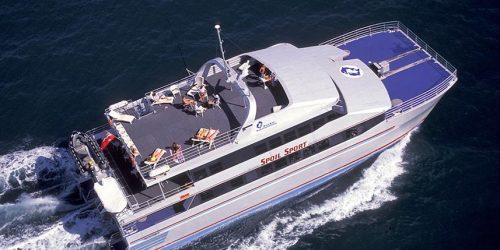 | Review: MY Spoilsport; Book: MY Spoilsport | 9.4 Superb | from £292; $356; €333 |
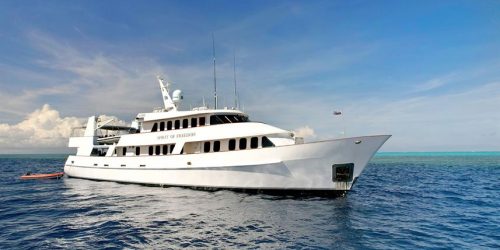 | Review: MY Spirit of Freedom; Book: MY Spirit of Freedom | 9.3 Superb | from £241; $294; €275 |
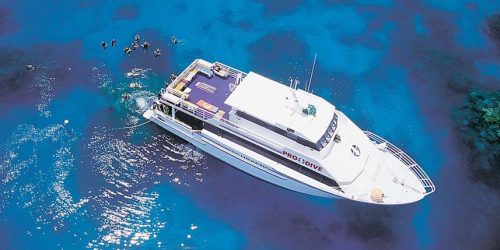 | Review: MY Pro Dive Cairns; Book: MY Pro Dive Cairns | 9.2 Superb | from £176; $215; €201 |
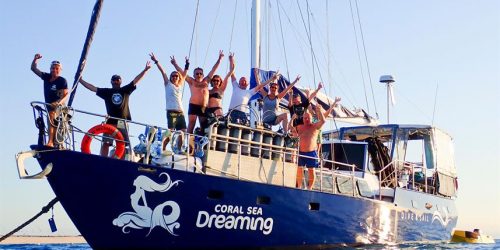 | Review: Coral Sea Dreaming; Book: Coral Sea Dreaming | 9.2 Superb | from £138; $168; €157 |
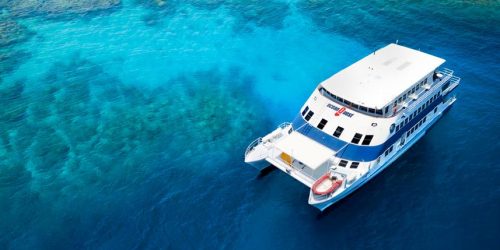 | Review: MY Ocean Quest; Book: MY Ocean Quest | 9 Superb | from £152; $185; €173 |
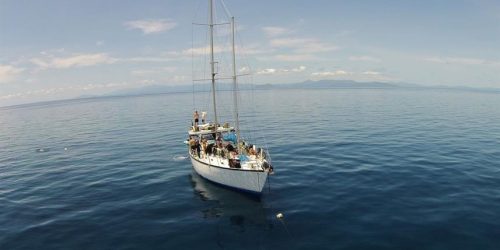 | Review: Rum Runner; Book: Rum Runner | 9 Superb | from £132; $161; €150 |
Note: The above “Price Per Day” was correct at the time of producing this article, as was the exchange rate used to convert the GBP cost to US Dollars and Euros. For an up-to-date cost for your chosen liveaboard, please visit the “Book” link above.
Dive Sites & Areas On The Great Barrier Reef
Osprey Reef Diving
Popular Osprey Reef liveaboards
| MY Spoilsport; Liveaboard diving in Australia; 9.4 out of 10 and is rated 'Superb'; from £292, $356, €333/day. Customer Review: “Doesn’t get much better……The diving was organised to a very professional standard. Nitrox was available (though an extra charge) and 15 litre tanks also available (again extra). Every dive was preceeded by a detailed briefing and a guide was available, though you could dive with a buddy if preferred. 4 or 5 dives a day were offered. Luckily we were blessed with great weather and easy dives. Probably the best dive was a shark feed – 40/50 reef sharks + giant cod all in a feeding frenzy. The food on board was excellent – all tastes and diets catered for. The cabins were very comfy – good bunks, adequate storage and functional bathroom. On the last night we had a party – some guests were professional musicians so we had a good show….& all the crew got everyone up dancing. I was a liveaboard virgin but now a total convert.” Recommended for: Organisation of diving, the crew, comfort of boat. |
| MY Spirit of Freedom; Liveaboard diving in Australia; 9.3 out of 10 and is rated 'Superb'; from £241, $294, €275/day. Customer Review: “A childhood dream realised. Impressively well run ship with enthusiastic, switched on crew. Little things like warm towels, kit taken care of, delicious food, made it a fantastic liveaboard. Highly highly recommend. Don’t miss out on the night dive!” Recommended for: Fantastic diving, comfortable ship, proficient crew. |
Osprey Reef has amazing visibility which can be up to 40 metres (131 feet), which is located in the Coral Sea and can only be accessed by Australian liveaboard. The reef is about 60 kilometres (37.5 miles) from any other reef and is 350 kilometres (219 miles) from Cairns in Queensland.
You are almost guaranteed sightings of sharks at North Horn, and divers enjoy small caverns and swim-throughs. When you set sail on a Cairns based liveaboard to Osprey Reef, you’ll be embarking on a trip to a remote unspoilt underwater wilderness.
Osprey Reef is full of vibrant colours and many sea creatures of all shapes and sizes.
When you dive Osprey Reef, you are likely to encounter pelagics, barracuda, giant trevally, green and loggerhead turtles, plus if you’re lucky hammerheads in the winter months. But then you may even witness humpback whales if you are diving between June and November.
Osprey Reef Shark Feed Dive
Osprey Reef’s North Horn will include Australia’s most famous shark feed dive where you’ll see grey reef sharks, silky sharks, silvertip sharks and hammerhead sharks.
Ribbon Reefs Diving
Popular Ribbon Reef Liveaboards
| MY Spoilsport; Liveaboard diving in Australia; 9.4 out of 10 and is rated 'Superb'; from £292, $356, €333/day. Customer Review: “Doesn’t get much better……The diving was organised to a very professional standard. Nitrox was available (though an extra charge) and 15 litre tanks also available (again extra). Every dive was preceeded by a detailed briefing and a guide was available, though you could dive with a buddy if preferred. 4 or 5 dives a day were offered. Luckily we were blessed with great weather and easy dives. Probably the best dive was a shark feed – 40/50 reef sharks + giant cod all in a feeding frenzy. The food on board was excellent – all tastes and diets catered for. The cabins were very comfy – good bunks, adequate storage and functional bathroom. On the last night we had a party – some guests were professional musicians so we had a good show….& all the crew got everyone up dancing. I was a liveaboard virgin but now a total convert.” Recommended for: Organisation of diving, the crew, comfort of boat. |
| MY Spirit of Freedom; Liveaboard diving in Australia; 9.3 out of 10 and is rated 'Superb'; from £241, $294, €275/day. Customer Review: “A childhood dream realised. Impressively well run ship with enthusiastic, switched on crew. Little things like warm towels, kit taken care of, delicious food, made it a fantastic liveaboard. Highly highly recommend. Don’t miss out on the night dive!” Recommended for: Fantastic diving, comfortable ship, proficient crew. |
Every liveaboard diving cruise visiting the Ribbon Reefs, will go to the famous Cod Hole, which is home to a family of friendly massive potato cod. These friendly fish will bring a smile to every diver and provide the best chance for videos and photographs. Ribbon Reefs are a chain of 10 reefs in the Coral Sea.
The Ribbon Reefs are to the north of Cairns and due to how remote they are, they are only reachable via a few Australia liveaboards. An Australia liveaboard trip to Ribbon Reefs means you will dive the “Snake Pit” where you are likely to see olive sea snakes, which are only found in a few places along the Great Barrier Reef.
The marine life includes macro life as well as large marine creatures such as turtles, rays and sharks. Divers will often see sharks and rays at Steve’s Bommie, together with schooling trevally and barracuda.
Most of the marine life is experienced in shallow dives of no more than 20 metres (66 feet), where you’ll see many of the GBR’s 1,500 species of fish and 400 species of coral too.
But if you sail on a liveaboard during the Australian winter, you may be lucky to see dwarf minke whales in this area too.
Bougainville Reef Diving
Popular Bougainville Reef liveaboards
| MY Spoilsport; Liveaboard diving in Australia; 9.4 out of 10 and is rated 'Superb'; from £292, $356, €333/day. Customer Review: “Doesn’t get much better……The diving was organised to a very professional standard. Nitrox was available (though an extra charge) and 15 litre tanks also available (again extra). Every dive was preceeded by a detailed briefing and a guide was available, though you could dive with a buddy if preferred. 4 or 5 dives a day were offered. Luckily we were blessed with great weather and easy dives. Probably the best dive was a shark feed – 40/50 reef sharks + giant cod all in a feeding frenzy. The food on board was excellent – all tastes and diets catered for. The cabins were very comfy – good bunks, adequate storage and functional bathroom. On the last night we had a party – some guests were professional musicians so we had a good show….& all the crew got everyone up dancing. I was a liveaboard virgin but now a total convert.” Recommended for: Organisation of diving, the crew, comfort of boat. |
| MY Spirit of Freedom; Liveaboard diving in Australia; 9.3 out of 10 and is rated 'Superb'; from £241, $294, €275/day. Customer Review: “A childhood dream realised. Impressively well run ship with enthusiastic, switched on crew. Little things like warm towels, kit taken care of, delicious food, made it a fantastic liveaboard. Highly highly recommend. Don’t miss out on the night dive!” Recommended for: Fantastic diving, comfortable ship, proficient crew. |
Bougainville Reef is found on the outer reef of the Great Barrier Reef. This means it can only be visited by liveaboard, but only when conditions permit. As a result of its remote location and minimal visits it offers some of the most unspoilt and pristine diving in all of Australia. Bougainville Reef is regularly frequented by manta rays and turtles.
SS Yongala Wreck Diving
Popular SS Yongala liveaboards
| MY Spoilsport; Liveaboard diving in Australia; 9.4 out of 10 and is rated 'Superb'; from £292, $356, €333/day. Customer Review: “Doesn’t get much better……The diving was organised to a very professional standard. Nitrox was available (though an extra charge) and 15 litre tanks also available (again extra). Every dive was preceeded by a detailed briefing and a guide was available, though you could dive with a buddy if preferred. 4 or 5 dives a day were offered. Luckily we were blessed with great weather and easy dives. Probably the best dive was a shark feed – 40/50 reef sharks + giant cod all in a feeding frenzy. The food on board was excellent – all tastes and diets catered for. The cabins were very comfy – good bunks, adequate storage and functional bathroom. On the last night we had a party – some guests were professional musicians so we had a good show….& all the crew got everyone up dancing. I was a liveaboard virgin but now a total convert.” Recommended for: Organisation of diving, the crew, comfort of boat. |
SS Yongala wreck is one of the finest dive sites in the world. The SS Yongala was sunk in 1911, which was enroute from Melbourne to Cairns when she steamed into a cyclone and sank south of Townsville.
The ship is relatively intact and the wreck’s depth starts at 15 metres (49 feet) below the surface and extends to 29 metres (95 feet) below the surface. The wreck has developed a mesmerising variety of corals and boasts some of the most diverse marine life on the whole of the GBR.
Other Great Barrier Reef Dive Sites
Milln Reef, which is the spot perfect for snorkelling and diving. Milln Reef is also a great place to do a night dive where you may see sleeping turtles. This reef is about 60 kilometres (37.5 miles) from Cairns, and comprises of 3 large coral pillars.
Flynn Reef, which includes Australia’s best coral garden. This is where you can see the full array of the Great Barrier Reef’s hard and soft coral.
Lizard Island is a national park located to the very far north of the Great Barrier Reef, which is a true tropical paradise.
I hope you enjoyed this page about Great Barrier Reef liveaboard diving
I’d love to hear from you. Tell us about your adventures of diving and snorkeling, in the comments below. Please also share your photos. Either from your underwater cameras or videos from your waterproof Gopro’s!
If this article hasn’t answered all of your questions. If you have more questions either about snorkeling or scuba diving (or specifically about Great Barrier Reef liveaboard diving), please comment below with your questions.
There will also be many more articles about scuba diving (and snorkeling) for you to read and learn about these fabulous sports.
Have fun and be safe!
Select Another Liveaboard Location
| All Liveaboard Locations |
| Specific Liveaboard Locations |
